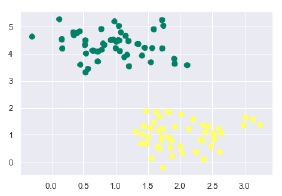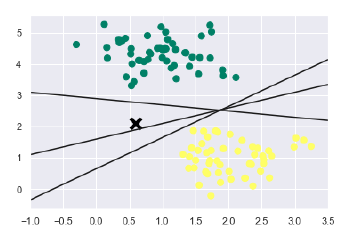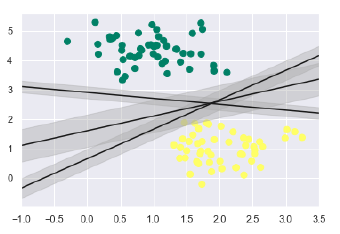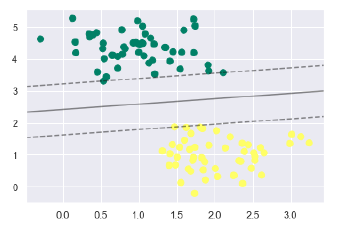- 入门教程
- 分类教程
- 回归教程
- 聚类教程
- KNN教程

分类算法 中的 Python实现函数
为了在Python中实现SVM,无涯教程将从标准库导入开始,如下所示-
import numpy as np import matplotlib.pyplot as plt from scipy import stats import seaborn as sns; sns.set()
接下来,从sklearn.dataset.sample_generator创建具有线性可分离数据的样本数据集,以使用SVM进行分类-
from sklearn.datasets.samples_generator import make_blobs X, y=make_blobs(n_samples=100, centers=2, random_state=0, cluster_std=0.50) plt.scatter(X[:, 0], X[:, 1], c=y, s=50, cmap='summer');
以下是生成具有100个样本和2个聚类的样本数据集后的输出-

知道SVM支持判别分类。它通过在二维的情况下简单地找到一条线,在多维的情况下通过歧管来简单地将类彼此划分。它在上述数据集上实现如下-
xfit = np.linspace(-1, 3.5) plt.scatter(X[:, 0], X[:, 1], c = y, s = 50, cmap = 'summer') plt.plot([0.6], [2.1], 'x', color = 'black', markeredgewidth = 4, markersize = 12) for m, b in [(1, 0.65), (0.5, 1.6), (-0.2, 2.9)]: plt.plot(xfit, m * xfit + b, '-k') plt.xlim(-1, 3.5);
输出如下-

从上面的输出中可以看到,有三种不同的分隔符可以完美地区分以上示例。
正如讨论的那样,SVM的主要目标是将数据集划分为类,以找到最大的边际超平面(MMH),而不是在类之间绘制零线,可以在每条线周围画出一定宽度的边界,直到最近的点。它可以做到如下-
xfit = np.linspace(-1, 3.5) plt.scatter(X[:, 0], X[:, 1], c = y, s = 50, cmap = 'summer') for m, b, d in [(1, 0.65, 0.33), (0.5, 1.6, 0.55), (-0.2, 2.9, 0.2)]: yfit = m * xfit + b plt.plot(xfit, yfit, '-k') plt.fill_between(xfit, yfit - d, yfit + d, edgecolor='none', color = '#AAAAAA', alpha = 0.4) plt.xlim(-1, 3.5);

从上面的输出图像中,无涯教程可以轻松地观察到判别式分类器中的"边距", SVM将选择使边距最大化的线。
来源:LearnFk无涯教程网
接下来,将使用Scikit-Learn的支持向量分类器在此数据上训练SVM模型。在这里,使用线性内核来拟合SVM,如下所示:
from sklearn.svm import SVC # "Support vector classifier" model = SVC(kernel = 'linear', C = 1E10) model.fit(X, y)
输出如下-
SVC(C=10000000000.0, cache_size=200, class_weight=None, coef0=0.0, decision_function_shape='ovr', degree=3, gamma='auto_deprecated', kernel='linear', max_iter=-1, probability=False, random_state=None, shrinking=True, tol=0.001, verbose=False)
现在,为了更好地理解,以下内容将绘制2D SVC的决策函数-
def decision_function(model, ax = None, plot_support = True): if ax is None: ax = plt.gca() xlim = ax.get_xlim() ylim = ax.get_ylim()
为了判断模型,需要创建网格,如下所示:
x = np.linspace(xlim[0], xlim[1], 30) y = np.linspace(ylim[0], ylim[1], 30) Y, X = np.meshgrid(y, x) xy = np.vstack([X.ravel(), Y.ravel()]).T P = model.decision_function(xy).reshape(X.shape)
接下来,需要绘制决策边界和边际,如下所示:
ax.contour(X, Y, P, colors='k', levels=[-1, 0, 1], alpha=0.5, linestyles=['--', '-', '--'])
现在,类似地绘制支持向量,如下所示:
if plot_support: ax.scatter(model.support_vectors_[:, 0], model.support_vectors_[:, 1], s=300, linewidth=1, facecolors='none'); ax.set_xlim(xlim) ax.set_ylim(ylim)
现在,使用此功能来拟合无涯教程的模型,如下所示:
plt.scatter(X[:, 0], X[:, 1], c=y, s=50, cmap='summer') decision_function(model);

无涯教程可以从上面的输出中观察到SVM分类器适合数据的边距,即虚线和支持向量,该适合度的关键元素与虚线接触。这些支持向量点存储在分类器的 support_vectors _属性中,如下所示-
model.support_vectors_
输出如下-
array([[0.5323772 , 3.31338909], [2.11114739, 3.57660449], [1.46870582, 1.86947425]])
祝学习愉快!(内容编辑有误?请选中要编辑内容 -> 右键 -> 修改 -> 提交!)
 《Python机器学习入门教程》
《Python机器学习入门教程》